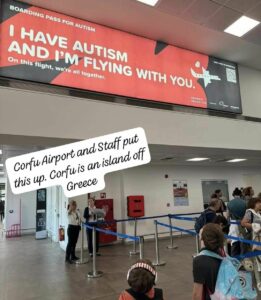
Corfu Island’s airport has recently gained attention for its autism awareness initiative, highlighting the growing need for airports to become more inclusive for individuals with autism. Airports can be overwhelming due to sensory overload—bright lights, noise, and large crowds. Simple visual aids, such as autism awareness posters, can help educate staff and passengers, fostering understanding, patience, and support.
Airports can take small, budget-conscious steps that still make a big difference. Creating quiet spaces by repurposing existing areas, for example, provides a calm environment for those feeling overwhelmed. Enhancing clear signage and visual guides with simple instructions helps travelers with autism navigate independently, reducing stress. Moreover, staff training on autism awareness, in partnership with local organizations or through free resources, is a cost-effective way to ensure staff are equipped to assist individuals with autism appropriately. Offering pre-visit virtual tours can also help travelers familiarize themselves with the airport, easing anxiety before their journey.
One often hears the argument, “We don’t have the budget for this,” when discussing accessibility initiatives. However, the challenge often lies in the fact that specific earmarks for comprehensive disability inclusion—encompassing all forms of disabilities, not just physical mobility—are less common. Funding for broader measures, such as sensory-friendly spaces or communication aids, may not be prioritized. Yet, as awareness grows, so too does the recognition of the need for more inclusive solutions.
The key is to ensure that accessibility initiatives address all disabilities, not just physical ones. Starting small—through focused, thoughtful efforts—can lead to meaningful change. It’s important to remember that progress in accessibility is driven by intent, not just budget. Even modest changes, such as staff training or repurposing quiet spaces, signal a shift toward a more autism-friendly environment. These early steps build awareness and lay the groundwork for more comprehensive solutions over time.
It’s time for airports to take action. Ensuring inclusivity and accessibility for all travelers, especially those with invisible disabilities like autism, will create a more welcoming travel experience for everyone.
